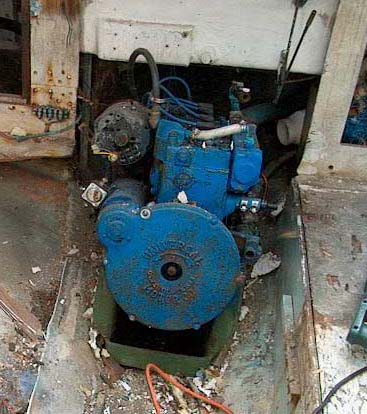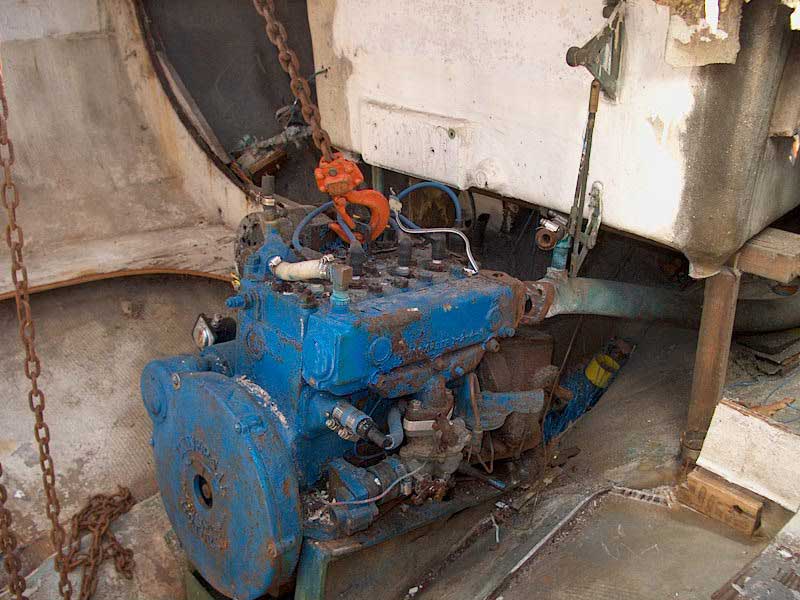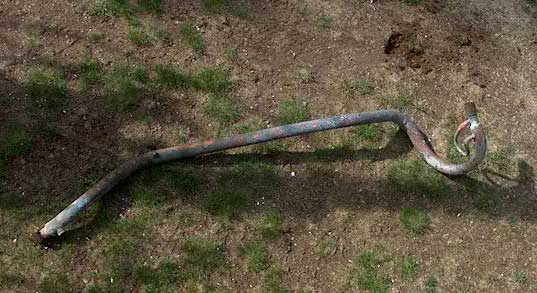|
| |
May 5, 2003
 During
some of my earlier days working on the interior of the boat, I had managed
to disconnect some of the engine connections (wiring, fuel line,
throttle). But I hadn't really concentrated on removing it.
When spring arrived, and I had cleared out more of the debris from earlier
interior demolitions, I decided one Sunday afternoon, spur of the moment,
that the time had come to pull the old Atomic 4 off its beds and out of
the boat, which could clear the way for further interior demolition. During
some of my earlier days working on the interior of the boat, I had managed
to disconnect some of the engine connections (wiring, fuel line,
throttle). But I hadn't really concentrated on removing it.
When spring arrived, and I had cleared out more of the debris from earlier
interior demolitions, I decided one Sunday afternoon, spur of the moment,
that the time had come to pull the old Atomic 4 off its beds and out of
the boat, which could clear the way for further interior demolition.
With the surrounding cabinetry already
removed, access to the engine mounting bolts and the still-attached copper
exhaust system was as good as it could get. Fortunately, when I
bought the boat, the propeller shaft and coupling had already been removed
by someone else, so I didn't have to fight with any of that; I would have
just cut the shaft anyway. A few days earlier, while already up in
the boat with some tools and my reciprocating saw, I had made a
half-hearted attempt to cut the engine bolts, but the saw blade was old
and couldn't do the job. Of course I had no spares at that time.
Armed with new blades, I attached the
engine with a vengeance a few days later. It was a gorgeous, warm
Sunday afternoon. We had company coming for dinner later that day,
but I had several hours to play with. I knew I could get the thing
out with no problem. |
|
The
first thing to do was unhook the original copper, water-jacketed exhaust
system from the manifold. Of course, the bolts were rusted in
place. Not amused by the prospect of days of flooding with PB
Blaster and waiting, I carefully cut the exhaust free by running the saw
through the gasketed area between the manifold and the exhaust flange,
erring on the side of cutting the flange instead of the manifold, since
the flange was most definitely a throwaway item; I didn't know what the
manifold status was, but didn't want to damage it nonetheless.
Thanks to some bad aim and a slightly bad
cutting angle, the blade didn't cut through the gasketed area (and the two
bolts holding the exhaust to the manifold) as straight as I had hoped, but
the error, as planned, was on the flange side. It took a couple or
three blades to get through the tough cast iron; the blades tended to snap
off at the chuck on the saw from the angle. But soon enough, it was
free; I found that with the icebox removed, I could actually sit on what
remained of the settee and pole part of my head through the opening,
making cutting about as comfy as it could have been.
With the exhaust free, I remembered one
final connection I had to remove before pulling the engine: the
mechanical gear linkage. What luck--the cotter pin actually pulled
immediately free, and the clevis pin came right out, freeing the linkage
in a pair of seconds. When I did the same operation a few years ago
on Glissando, the pin was frozen solid, and was a real bear to
break free. |
|
 Before
continuing, I decided to set up my chain hoist and attach it to the
engine, so that in case the engine wanted to move once the bolts were cut,
it couldn't go far. I was a little wary of the remaining strength in
the coachroof, which would have to support the beam and weight of the
engine; the coachroof is so water-soaked that it's sagging from weakness
and additional weight. Still, all I wanted to avoid was injury; if
the coachroof broke from the weight, no big deal, since it's going to be
cut off anyway. With that in mind, I placed my lifting beam--a
length of pressure treated 4x6--across the companionway, wrapped a chain
around it, and hooked up the chain hoist, attaching the hook to the
lifting ring on the engine and taking up most of the slack. Before
continuing, I decided to set up my chain hoist and attach it to the
engine, so that in case the engine wanted to move once the bolts were cut,
it couldn't go far. I was a little wary of the remaining strength in
the coachroof, which would have to support the beam and weight of the
engine; the coachroof is so water-soaked that it's sagging from weakness
and additional weight. Still, all I wanted to avoid was injury; if
the coachroof broke from the weight, no big deal, since it's going to be
cut off anyway. With that in mind, I placed my lifting beam--a
length of pressure treated 4x6--across the companionway, wrapped a chain
around it, and hooked up the chain hoist, attaching the hook to the
lifting ring on the engine and taking up most of the slack.
|
|
With
a fresh blade in the reciprocating saw, I made short work of the four
bolts securing the engine; the engine was installed with small spacers, or
shims, between the mounting flange and the engine foundation, so it was a
cinch to get the blade in there and cut the decades-old bolts.
With the bolts cut, it took only a little
gentle persuasion with a flat bar to get the engine to move forward, and
then swing free into the cabin. I lowered it temporarily to the
cabin sole, since I had to reposition and raise the lifting beam in order
to get the engine through the companionway.
From here, it's probably best to let
pictures do the talking. Please click on the small photos to see a
full-size version.
|
 |
To
pull the engine from its beds, and into the cabin, I first set up a basic
hoisting rig consisting of a 4x6 pressure-treated beam that I laid across
the companionway. Because of the rearward angle the chain would have
to take initially, I clamped the beam in place. I hit my head many
times on those pony clamp handles! |
The
hoist is attached to the lifting ring on the engine, and ready to pull it
up and out. Some gentle persuasion with a flat bar was necessary to
help it off the foundation, since the aft end lifted first, tending to
make the forward end stick. |
 |
 |
Soon,
though, the engine was free and swung forward beneath the hoist. |
I
lowered the engine temporarily to the cabin sole so I could reposition the
hoist and raise it up a bit for the next step. I could have done
this all with only one hoist position, but didn't realize at first that
I'd need additional clearance to hoist the engine from the cabin. |
 |
 |
Where
the engine had resided for who knows how long (perhaps never removed?),
there was a lovely collection of gunk. This engine foundation will
be removed later. |
I raised the beam up with a
couple blocks, and actually screwed the beam to the blocks, and the blocks
directly to the companionway trim. This stuff is all
expendable since the whole deck will be removed and thrown away for this
project. |
 |
 |
With
the new beam position, it was no problem to lift the engine up and pull it
onto the bridgedeck. Still, I virtually two-blocked the hoist in the
process--another few inches would have been nice, but I always seem to end
up with minimal hoist clearance for some reason. |
The
engine, resting on the bridgedeck. Just another view. |
 |
 |
Another
view of the rusty Atomic 4. |
I
pushed the engine over to the side of the cockpit, as I didn't have time
to rig a hoist to lower it to the ground. Later, I covered it with
some plastic to protect it from rain. |
 |
|
The original copper water-jacketed exhaust had
to come out too. I could have left it in until some of the deck and
cockpit was removed, which would have made it easy to get the bulky,
heavy, 10 foot-long pipe out of the boat--but where's the challenge in
that? To remove it, I first had to cut the rotted hose securing it
to the transom outlet. Then, with much twisting, turning, pushing,
shoving, and so forth, I finally managed to pull the thing out in one
piece, through the port cockpit locker.

|
Continue with the engine removal.>
|
|

 During
some of my earlier days working on the interior of the boat, I had managed
to disconnect some of the engine connections (wiring, fuel line,
throttle). But I hadn't really concentrated on removing it.
When spring arrived, and I had cleared out more of the debris from earlier
interior demolitions, I decided one Sunday afternoon, spur of the moment,
that the time had come to pull the old Atomic 4 off its beds and out of
the boat, which could clear the way for further interior demolition.
During
some of my earlier days working on the interior of the boat, I had managed
to disconnect some of the engine connections (wiring, fuel line,
throttle). But I hadn't really concentrated on removing it.
When spring arrived, and I had cleared out more of the debris from earlier
interior demolitions, I decided one Sunday afternoon, spur of the moment,
that the time had come to pull the old Atomic 4 off its beds and out of
the boat, which could clear the way for further interior demolition. Before
continuing, I decided to set up my chain hoist and attach it to the
engine, so that in case the engine wanted to move once the bolts were cut,
it couldn't go far. I was a little wary of the remaining strength in
the coachroof, which would have to support the beam and weight of the
engine; the coachroof is so water-soaked that it's sagging from weakness
and additional weight. Still, all I wanted to avoid was injury; if
the coachroof broke from the weight, no big deal, since it's going to be
cut off anyway. With that in mind, I placed my lifting beam--a
length of pressure treated 4x6--across the companionway, wrapped a chain
around it, and hooked up the chain hoist, attaching the hook to the
lifting ring on the engine and taking up most of the slack.
Before
continuing, I decided to set up my chain hoist and attach it to the
engine, so that in case the engine wanted to move once the bolts were cut,
it couldn't go far. I was a little wary of the remaining strength in
the coachroof, which would have to support the beam and weight of the
engine; the coachroof is so water-soaked that it's sagging from weakness
and additional weight. Still, all I wanted to avoid was injury; if
the coachroof broke from the weight, no big deal, since it's going to be
cut off anyway. With that in mind, I placed my lifting beam--a
length of pressure treated 4x6--across the companionway, wrapped a chain
around it, and hooked up the chain hoist, attaching the hook to the
lifting ring on the engine and taking up most of the slack.









